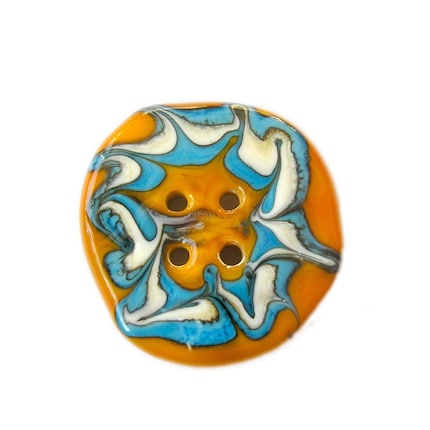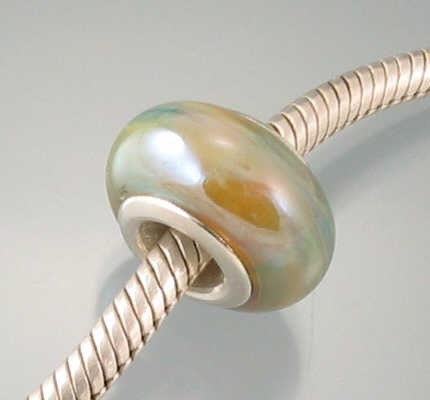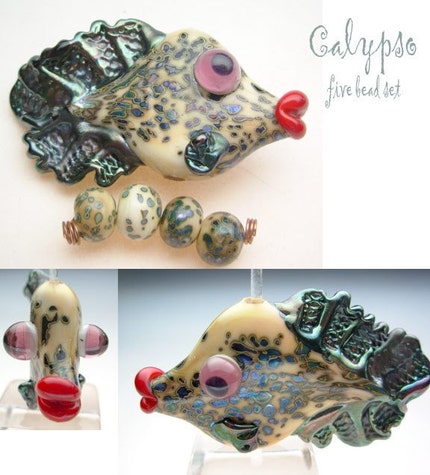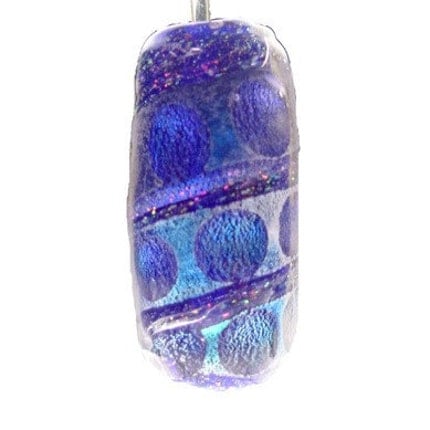Silver in glass? Yes, metals are common elements. Copper and Lead are also common in glass. If you are curious about what these metals do, check out the Bullseye website which lists the elements in a particular glass and what other elements may cause a reaction.
Glass artists are often looking for a reaction. One glass makes another "bleed" and create striations of color. Or the lovely black line that appears when turquoise touches ivory or coral. This button by fellow Fire Diva Rivers Edge is a perfect example. See the black line between the colors? That's a color reaction.
 But back to the silver. Silver adds amazing shine to glass...a spectacular sheen! You can see what I'm referring to on this pandora style glass bead by Giapet.
But back to the silver. Silver adds amazing shine to glass...a spectacular sheen! You can see what I'm referring to on this pandora style glass bead by Giapet. This is a specific reaction that occurs when a silver saturated glass is "reduced." Reducing or reduction flames are mostly propane, starving the bead of oxygen. Silver needs oxygen to be a happy camper in the glass and when starved for oxygen, the silver molecules gather on the surface of the bead...where there is more oxygen in the air. Reduction is usually the last thing done to a bead before popping it in a kiln. This keeps the silver on the surface, creating that beautiful rich shine!
This is a specific reaction that occurs when a silver saturated glass is "reduced." Reducing or reduction flames are mostly propane, starving the bead of oxygen. Silver needs oxygen to be a happy camper in the glass and when starved for oxygen, the silver molecules gather on the surface of the bead...where there is more oxygen in the air. Reduction is usually the last thing done to a bead before popping it in a kiln. This keeps the silver on the surface, creating that beautiful rich shine!Here are another example. My fish has silver glass fins and the speckles on his body are silver glass as well.

Silver glass is very popular in spite of the cost. Starting at around $48 / pound and going up to $100 / pound, it's best used sparingly!
But that is not the ONLY thing silver does to glass. Silvered ivory is another term you hear alot, certainly on this blog! It's one of my favorite techniques! I simply love the rugged, ancient look you can get but adding fine (.999 pure) silver to ivory glass. Here are two examples, the first by Janel Dudley Beads called Sprouts. Check out the bottom half of her bead:

The second bead, I made. It features both techniques...silvered ivory on the inside with silver saturated glass on the dots and surface decoration.

The last glass I would like to show off to you is called dichroic. Dichroic glass was actually invented for NASA - I can't imagine what for but, I'm sure glad they shared it with the glass industry! This definition is from the website of CBS-dichroic, the best known manufacturer: "Quartz Crystal and Metal Oxides are Vaporized with an electron beam gun in an airless vacuum chamber and the vapor then floats upward and attaches then condenses on the surface of the glass in the form of a crystal structure."
Fancy, huh?? Well, the results are beautiful, sparkly and double colored....hence the name di = two; chroic = color! The two color are the color you see looking straight on at the glass and the color that light reflects back. See how the strips of dichroic look purple AND gold:
 This bead is a perfect example of ways to use dichroic: There are THREE techniques here: Surface, encased and what one of my favorite teachers, Janet Andersen calls "party stringer."
This bead is a perfect example of ways to use dichroic: There are THREE techniques here: Surface, encased and what one of my favorite teachers, Janet Andersen calls "party stringer." That surface coating is the subject of much debate among lampworkers. Many say you cannot put the coating on the outside... but you can. You see it right there. The trick is, you MUST work cool. Too hot, and you have scum! But it can be done! Keep the coating away from the flame and wrap in reverse.... and keep working cool!
That surface coating is the subject of much debate among lampworkers. Many say you cannot put the coating on the outside... but you can. You see it right there. The trick is, you MUST work cool. Too hot, and you have scum! But it can be done! Keep the coating away from the flame and wrap in reverse.... and keep working cool!The dots on the bead are clear, clear glass traps the coating and makes it crackle and get all interesting. Most the dichroic you see is trapped under clear. That doesn't mean it's any less challenging to work. Many bead makers will clip a small piece of dichroic into their hemostats with the coating side up to stick into the flame without burning it off...but with me, my hemos fall over and then I'm panicked with a hot bead in the flame! OY!
But then I remembered an old fusing trick! Lay your fingernails on the glass. If your nail is touching the glass, you are touching the dichroic. If there is a visual "skip" between your nail and the glass, you are touching the glass side. The dichroic coating is on the back and creating a mirror effect! I can lay down my hemos and check with one hand while keeping that bead warm!
The final technique - exemplified by the pink and gold thin ribbon running around the bead between the surface application is party stringer. Lay down several strips dichroic onto a hot clear rod. Case well and pull. This makes dichro go a long way...which is a good thing! It too is pricey, running from 65 cents an INCH to 1.50 an INCH.
Check back tomorrow for some twisted beads!









No comments:
Post a Comment